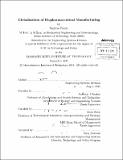Globalization of biopharmaceutical manufacturing
Author(s)
Pande, Rachna
DownloadFull printable version (9.388Mb)
Other Contributors
Massachusetts Institute of Technology. Technology and Policy Program.
Advisor
Anthony J Sinskey and Scott Stern.
Terms of use
Metadata
Show full item recordAbstract
The biomanufacturing industry is changing due to increasing globalization. However, it is changing differently from other high tech industries like software/ semiconductor/ automobiles. In this study we use global biomanufacturing investment data, industry survey data as well as interviews with members of industry and academia to understand the extent of microbial biomanufacturing activity (total volume, number of facilities, type of facilities) and nature of biomanufacturing activity (complexity of products and processes across both mammalian and microbial production) in different regions of the world today. The study shows that traditional centers of expertise in US and EU still house most of the worlds biomanufacturing capacity. The facilities in US and EU perform a larger number of operations within their facilities and also more technically complex operations than facilities in Asia. US facilities support the most complex products (median unit operations =13) and processes (cell culture, purification) and maximum average products per facility(12.2). Asian facilities support simpler products (median unit operations =7), simpler processes (fermentation, fill/finish) and fewer products per facility on average (3.25). These results support the idea that managing technical complexity is one of the biggest challenges in biomanufacturing today and it can determine where a biologic can be manufactured. While economic forces push manufacturing of biologics to low cost locations, the need to develop expertise may prevent manufacturing from scattering across the world. Instead, there may be a more guided flow to locations with an expertise in certain types of products and processes.
Description
Thesis (S.M. in Technology and Policy)--Massachusetts Institute of Technology, Engineering Systems Division, Technology and Policy Program, 2011. Cataloged from PDF version of thesis. Includes bibliographical references (p. 131-134).
Date issued
2011Department
Massachusetts Institute of Technology. Engineering Systems DivisionPublisher
Massachusetts Institute of Technology
Keywords
Engineering Systems Division., Technology and Policy Program.